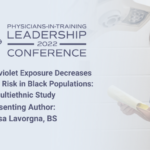Abstract | April 5, 2022
Ambient Ultraviolet Exposure Decreases Thyroid Cancer Risk in Black Populations: A Multiethnic Study
Learning Objectives
- Discuss the impact of ultraviolet radiation on thyroid cancer incidence rates with an emphasis on differences across races and ethnicities;
- Describe the overall race-based differences in thyroid cancer overall incidence and 5-year survival rates.
Background/Knowledge Gap: Thyroid cancer is the most prevalent endocrine tumor with 44,280 cases projected to occur in 2021 alone. Increased ultraviolet (UV) solar exposure and subsequent Vitamin D levels have been inversely associated with incidences of other solid malignancies, including prostate, female breast, and ovarian cancers due to its ability to inhibit angiogenesis and tumor cell progression. However, no research to date has investigated race-based differences in UV exposure as a protective factor against thyroid cancer development.
Methods/Design: Overall estimates of thyroid cancer in the United States were retrieved from the National Program of Cancer Registries, and the Surveillance, Epidemiology, and End Results (SEER) Database from 2001 to 2018. Data was stratified for population structure per geographic state. UV exposure data in Watt-Hours Per Square Meter for state was obtained from the NCI Cancer Atlas. Linear regression analysis was employed to test the role of residential UV exposure as an independent predictor risk factor for thyroid cancer across racial and ethnic groups.
Results/Findings: UV exposure was not significantly correlated with thyroid cancer incidence when analyzed across all races (r = -0.299, p=0.035). However, UV exposure was negatively correlated with thyroid cancer rates in Black populations specifically (r = -0.56, p< 0.001). Additionally, Black populations demonstrated the lowest thyroid cancer incidence rate (8.7 per 100,000) while White populations had the highest rate (14.7 per 100,000) in 2014 to 2018. Despite this, Black men had the worst 5-year survival rates when compared to white and combined other ethnic populations (88.2% vs. 94.9% vs. 95.9%).
Conclusions/Implications: UV exposure may be a protective factor against incidence of thyroid cancer in Black populations while having minimal protection in other multi-ethnic groups. This may contribute to black populations having the lowest incident rate of thyroid cancer development. This finding may contribute to community health initiatives that can discuss the importance of appropriate UV exposure as a protective factor against thyroid cancer in Black populations.
References and Resources:
- Society AAC. Cancer Facts & Figures 2021. CA: A Cancer Journal for Clinicians 2021.
- Rahib L, Smith BD, Aizenberg R, Rosenzweig AB, Fleshman JM, Matrisian LM. Projecting cancer incidence and deaths to 2030: the unexpected burden of thyroid, liver, and pancreas cancers in the United States. Cancer Res 2014;74:2913-21.
- Zamoiski RD, Cahoon EK, Freedman DM, Linet MS, Kitahara CM. Prospective Study of Ultraviolet Radiation Exposure and Thyroid Cancer Risk in the United States. Cancer Epidemiol Biomarkers Prev 2017;26:684-91.

